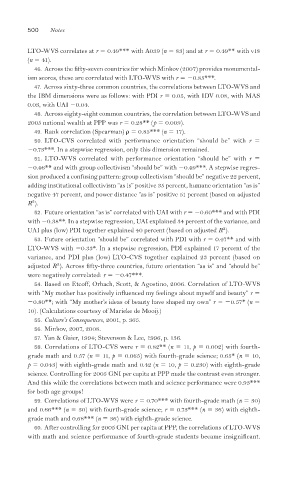Page 535 - Cultures and Organizations
P. 535
500 Notes
LTO-WVS correlates at r 0.49*** with A039 (n 83) and at r 0.49** with v18
(n 41).
46. Across the fifty-seven countries for which Minkov (2007) provides monumental-
ism scores, these are correlated with LTO-WVS with r 0.85***.
47. Across sixty-three common countries, the correlations between LTO-WVS and
the IBM dimensions were as follows: with PDI r 0.05, with IDV 0.08, with MAS
0.03, with UAI 0.04.
48. Across eighty-eight common countries, the correlation between LTO-WVS and
2005 national wealth at PPP was r 0.28** (p 0.009).
49. Rank correlation (Spearman) 0.85*** (n 17).
50. LTO-CVS correlated with performance orientation “should be” with r
0.73***. In a stepwise regression, only this dimension remained.
51. LTO-WVS correlated with performance orientation “should be” with r
0.46** and with group collectivism “should be” with 0.49***. A stepwise regres-
sion produced a confusing pattern: group collectivism “should be” negative 22 percent,
adding institutional collectivism “as is” positive 35 percent, humane orientation “as is”
negative 47 percent, and power distance “as is” positive 51 percent (based on adjusted
2
R ).
52. Future orientation “as is” correlated with UAI with r 0.60*** and with PDI
with 0.38**. In a stepwise regression, UAI explained 34 percent of the variance, and
2
UAI plus (low) PDI together explained 40 percent (based on adjusted R ).
53. Future orientation “should be” correlated with PDI with r 0.47** and with
LTO-WVS with 0.33*. In a stepwise regression, PDI explained 17 percent of the
variance, and PDI plus (low) LTO-CVS together explained 23 percent (based on
2
adjusted R ). Across fi fty-three countries, future orientation “as is” and “should be”
were negatively correlated: r 0.47***.
54. Based on Etcoff, Orbach, Scott, & Agostino, 2006. Correlation of LTO-WVS
with “My mother has positively influenced my feelings about myself and beauty” r
0.80**; with “My mother’s ideas of beauty have shaped my own” r 0.57* (n
10). (Calculations courtesy of Marieke de Mooij.)
55. Culture’s Consequences, 2001, p. 365.
56. Minkov, 2007, 2008.
57. Yan & Gaier, 1994; Stevenson & Lee, 1996, p. 136.
58. Correlations of LTO-CVS were r 0.82** (n 11, p 0.002) with fourth-
grade math and 0.57 (n 11, p 0.065) with fourth-grade science; 0.65* (n 10,
p 0.043) with eighth-grade math and 0.42 (n 10, p 0.230) with eighth-grade
science. Controlling for 2005 GNI per capita at PPP made the contrast even stronger.
And this while the correlations between math and science performance were 0.93***
for both age groups!
59. Correlations of LTO-WVS were r 0.70*** with fourth-grade math (n 30)
and 0.66*** (n 30) with fourth-grade science; r 0.73*** (n 36) with eighth-
grade math and 0.68*** (n 36) with eighth-grade science.
60. After controlling for 2005 GNI per capita at PPP, the correlations of LTO-WVS
with math and science performance of fourth-grade students became insignifi cant.

